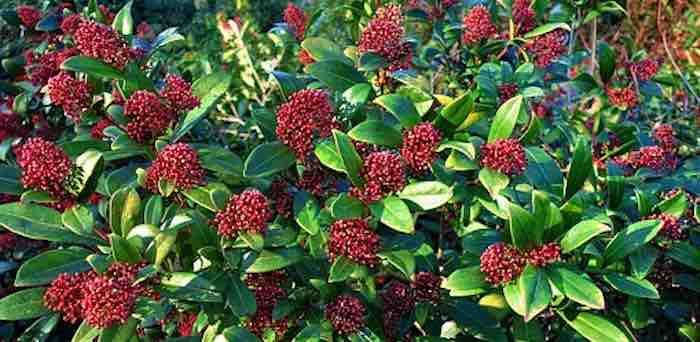By Wes Porter ——Bio and Archives--August 31, 2019
Lifestyles | CFP Comments | Reader Friendly | Subscribe | Email Us

Selecting flowering shrubs, double your pleasure. Some easy-to-find have colourful berries as well. While many lists may be found, not all mention some recommendations have drawbacks. Not the least of these in eventual size. For example, Russian Olive Elaeagnus angustifolia can grow to be a small tree. Its Canadian equivalent, Silver Buffaloberry, Shepherdia canadensis, is a large, 15-foot, shrub and likewise probably not for a small garden.
European High Bush-cranberry, V. opulus, is also a large 12-foot bush. True there is a dwarf form but has few blooms and no fruit. Worse, many of not all viburnums are subject to serious attack from an introduced pest, the now notorious viburnum leaf beetle.
Although there are larger selections, many Cotoneasters are ideal choices for confined spaces. Low growing and sprawling selections include Creeping Rockspray (C. adpressa), ‘Skogholm’ Cotoneaster (C. dammeri) and Rockspray (C. horozontalis). Taller, to about 6-plus feet, are European Cotoneaster (C. integerrima) and Showy Cotoneaster (C. multiflora). These all bear red berries although there are others that produce not so attractive black fruit.
Planted alongside a sunny fence or wall Scarlet Firethorn (Pyracatha coccinea), although not a true vine, will lean against supporting structure, up to 6 feet high.
While many roses produce red fruit, few are propagated commercially for their production. The floral emblem of Alberta, for example, Rosa acicularis, not only has this attribute but is also extremely hardy. Far more widely available are the numerous cultivars of the oriental Beach Rose, Rosa rugosa, very hardy and almost continuous flowering. The large ‘hips,’ or fruit, are edible.
The Honeysuckles, Lonicera, tend to be medium to large bushes not all with attractive fruit. One of the most widely planted, the Tartarian Honeysuckle (L. tartarica) has cultivars with flowers of varying colour, followed by red or yellow fruits on bushes up to 9 feet tall. The Amur Honeysuckle (L. maackii)
Purple-leaf Sandcherry, Prunus cistena, a medium-sized shrub, can become somewhat straggly and should by pruned back hard every few years.
There are a few evergreen bushes as well. Oregon Grape (Mahonia aquifolium), native to the Pacific northwest, has yellow flowers over holly-like foliage in spring, followed by blue berries on a short shrub. Incidentally these are edible. The berries of Yews (Taxus) and Junipers (Juniperus) attractive as they are, should never, ever be so much as tasted.
Red:
Cotoneaster (Cotoneasters)
Lonicera (Honeysuckles)
Pyracantha (Firethorns)
Rosa (Roses)
Shepherdia canadensis (Silver Buffaloberry)
Taxus (Yews)
Viburnum (Viburnums)
Blue:
Juniperus communis (Common Juniper)
Purple:
Prunus cistena (Purple-leaf Sandcherry)
Yellow:
Elaeagnus angustifolia (Russian Olive)
View Comments
Wes Porter is a horticultural consultant and writer based in Toronto. Wes has over 40 years of experience in both temperate and tropical horticulture from three continents.